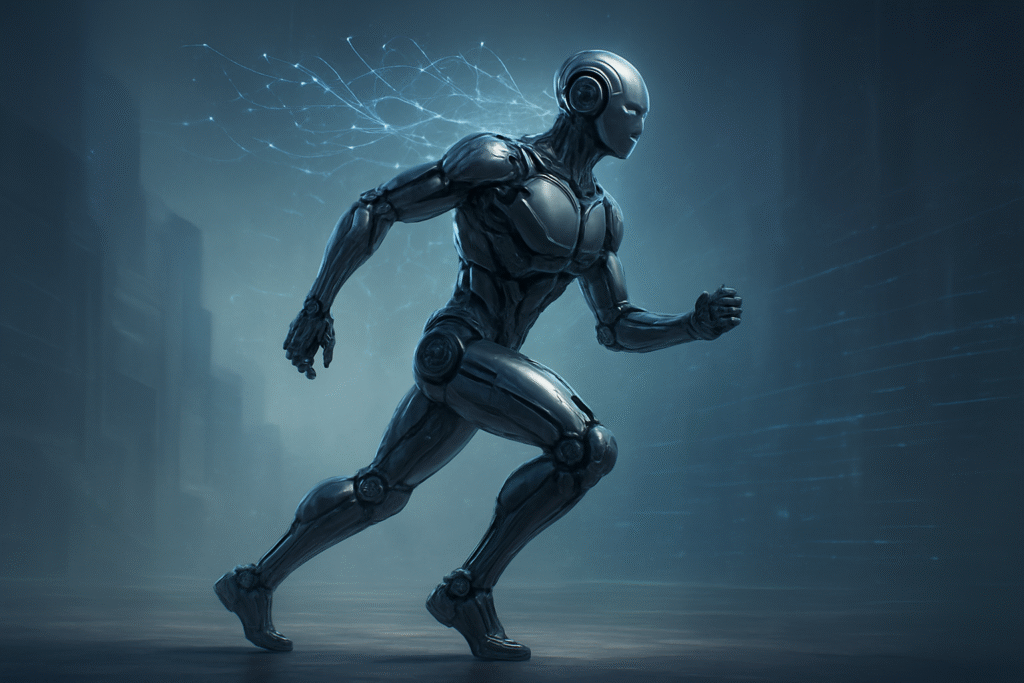
The world of artificial intelligence and robotics is currently witnessing an unprecedented surge in humanoid robot development, marked by both breathtaking advancements and humbling setbacks. From agile dancers and factory workers to potential domestic assistants, these human-like machines are rapidly evolving, promising to reshape industries and daily life. Yet, as their capabilities grow, so too do the challenges and public scrutiny, vividly underscored by the recent public debut and unfortunate fall of Russia's 'human' robot, AIdol, in Moscow on November 11, 2025. This incident, alongside other high-profile demonstrations, offers a potent snapshot of the current state of AI robotics—a field brimming with innovation, ambition, and the persistent hurdles of physical world deployment.
Technical Marvels and Mechanical Missteps: Unpacking the State of Humanoid Robotics
The past year has been a crucible for humanoid robotics, with several companies unveiling robots that push the boundaries of mobility, dexterity, and AI integration. Chinese electric vehicle company Xpeng (HKG: 9868) recently showcased its "Iron" humanoid robot in November 2025, boasting lifelike movements so convincing that its creators had to perform an on-stage dissection to prove its mechanical nature. Iron features "dexterous hands" with 22 degrees of flexibility per hand, a human-like spine, and an AI "brain" integrating Vision-Language-Task (VLT), Vision-Language-Action (VLA), and Vision-Language-Model (VLM) for autonomous decision-making. Similarly, Shenzhen-based Leju Robotics debuted "Kuafu" (Kuavo) as the "Zero Torchbearer" at the 15th National Games of China relay in November 2025, demonstrating breakthroughs in dynamic motion control and load-bearing stability, aided by 5G-Advanced (5G-A) technology for seamless remote control.
These advancements contrast sharply with previous generations of robots, primarily through their enhanced autonomy, sophisticated AI integration, and a marked shift towards electric actuation systems. Tesla's (NASDAQ: TSLA) Optimus Gen 2, unveiled in December 2023, showcased improved joint articulation and a sleeker design, learning from real-world data for industrial and domestic tasks. Boston Dynamics, a long-time pioneer, retired its iconic hydraulic Atlas robot in April 2024, introducing a new, fully electric version capable of "superhuman" movements and real-time adaptation in industrial settings. Figure AI's Figure 02, deployed at BMW's manufacturing plant in Spartanburg, South Carolina, in August 2024, is performing tasks like picking up metal sheets, demonstrating autonomous operation in real industrial environments. These robots leverage cutting-edge generative AI, large language models, reinforcement learning, and advanced sensor technologies, allowing them to learn tasks through imitation and refine skills autonomously. The initial reaction from the AI research community and industry experts is one of cautious optimism, recognizing the immense potential while acknowledging the significant engineering and AI challenges that remain, as highlighted by incidents like AIdol's fall.
Reshaping the AI Landscape: Competitive Implications and Market Disruption
The rapid evolution of humanoid robots has profound implications for AI companies, tech giants, and startups alike. Companies like Xpeng, Leju Robotics, Unitree Robotics, Tesla, Boston Dynamics, Figure AI, and 1X Technologies are at the forefront, vying for market leadership. Unitree Robotics, for instance, has strategically priced its H2 model at $29,900 for commercial use, significantly undercutting previous expectations and leveraging China's robust component manufacturing capabilities. This aggressive pricing strategy, combined with the agility of its smaller G1 model, positions Unitree as a significant disruptor.
The competitive landscape is intensifying, with major investments flowing into leading startups such as Apptronik ($350 million), Agility Robotics ($400 million), and Figure AI ($675 million Series B). Tech giants like NVIDIA (NASDAQ: NVDA) and Google DeepMind (Alphabet Inc. – NASDAQ: GOOGL) are also making substantial contributions to AI for robotics, developing advanced models and platforms that power these humanoids. China, in particular, has positioned humanoid robotics as a strategic national priority, with government policies aiming for "production at scale" by 2025. Chinese companies now account for 61% of robot unveilings since 2022 and dominate 70% of component supply chains, signaling a potential shift in global leadership in this domain. The potential disruption to existing products and services is immense, with humanoids poised to enter manufacturing, logistics, eldercare, and eventually, domestic services, challenging traditional labor models and creating new market segments. Companies that can successfully navigate the technical hurdles and achieve reliable, cost-effective mass production stand to gain significant strategic advantages and market positioning.
The Wider Significance: Humanoids in the Broader AI Tapestry
The advancements in humanoid robotics are not isolated but rather a convergence point for broader AI landscape trends. They represent the physical embodiment of breakthroughs in generative AI, large language models, and advanced perception systems. The ability of robots like Xpeng's Iron to understand and execute complex tasks based on visual and linguistic cues demonstrates the practical application of cutting-edge AI research in real-world, unstructured environments. This integration fits into a larger narrative of AI moving beyond software applications to embodied intelligence, capable of interacting with and manipulating the physical world.
The impacts are far-reaching, from revolutionizing industrial automation, as seen with Figure AI's deployment at BMW and UBTECH's (HKG: 9880) Walker S1 in EV factories, to addressing societal challenges like eldercare with Fourier Intelligence's GR-2. However, these advancements also bring potential concerns. The incident with Russia's AIdol serves as a stark reminder of the ongoing challenges in achieving robust stability, reliability, and safety in complex humanoid systems. This echoes past incidents like the "Boris the Robot" deception in 2018, where a man in a costume was presented as a sophisticated robot, or FEDOR's (Skybot F-850) ISS docking failure in 2019. While these past events highlighted basic engineering and transparency issues, AIdol's fall, despite the robot's purported capabilities, underscores the inherent difficulty in translating laboratory successes to flawless public demonstrations and real-world deployment. The societal implications regarding job displacement, ethical considerations of autonomous decision-making, and the psychological impact of human-like machines are also growing topics of discussion.
Glimpsing the Horizon: Future Developments in Humanoid Robotics
The trajectory of humanoid robot development points towards an exciting and transformative future. Experts predict that hundreds to low thousands of humanoid robots will be deployed industrially by 2025-2026, with consumer applications following within 2-4 years. Near-term developments will likely focus on improving battery life, reducing manufacturing costs, and enhancing safety protocols to ensure seamless integration into various environments. Companies like 1X Technologies, backed by OpenAI, have ambitious plans to deploy hundreds to thousands of their NEO humanoids in actual homes by the end of 2025, signaling a rapid push towards consumer accessibility.
Potential applications on the horizon are vast, extending beyond manufacturing and logistics to eldercare, domestic assistance, hazardous environment exploration, and even entertainment. Robots like Pudu Robotics' D9, capable of navigating stairs and performing tasks like cleaning, offer a glimpse into future service roles. The key challenges that need to be addressed include achieving full autonomy in highly unstructured and dynamic environments, refining human-robot interaction to be intuitive and natural, and developing robust ethical frameworks for their operation. Experts predict that continued breakthroughs in AI, particularly in areas like reinforcement learning from human demonstration and adaptive control systems, will lead to increasingly sophisticated and versatile humanoids. The goal is to develop robots that can operate for multi-hour shifts, learn from human demonstrations, and interact naturally in unstructured environments, moving closer to the vision of a truly helpful and adaptable artificial companion or worker.
A Pivotal Moment: Reflecting on Humanoid AI's Trajectory
The current era in humanoid robot development is undeniably a pivotal moment in AI history. We are witnessing a dual narrative of incredible progress—with robots demonstrating unprecedented dexterity, intelligence, and real-world utility—interspersed with the humbling reality of mechanical and software challenges, as exemplified by AIdol's public tumble. The key takeaway is that while the vision of ubiquitous, highly capable humanoids is rapidly approaching, the journey is not without its inevitable stumbles and learning curves.
This period marks a significant shift from theoretical research to practical, albeit nascent, commercial deployment. The sheer volume of investment, the strategic focus of nations like China, and the rapid pace of technical breakthroughs underscore the profound significance of this development in the broader AI landscape. The long-term impact promises to be transformative, reshaping industries, redefining labor, and fundamentally altering our interaction with technology. In the coming weeks and months, the world will be watching for further commercial deployments, continued advancements in AI integration, reductions in cost, and, crucially, improvements in the reliability and safety of these fascinating, human-like machines. The race to perfect the humanoid robot is on, and every step, both forward and backward, contributes to our understanding of what it means to build intelligence in a physical form.
This content is intended for informational purposes only and represents analysis of current AI developments.
TokenRing AI delivers enterprise-grade solutions for multi-agent AI workflow orchestration, AI-powered development tools, and seamless remote collaboration platforms.
For more information, visit https://www.tokenring.ai/.







